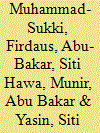|
|
|
Sort Order |
|
|
|
Items / Page
|
|
|
|
|
|
|
| Srl | Item |
| 1 |
ID:
110737


|
|
|
|
|
| Publication |
2011.
|
| Summary/Abstract |
This paper examines solar energy development in Malaysia, particularly in relation to the installation of solar Photovoltaic (PV) in residential houses. It analyzes the past activities related to solar energy in Malaysia, in terms of research and developments (R&Ds), the implementations used as well as the national policies for the past 20 years which have pushed the installation of PV in the country. The Feed-In Tariff (FiT) scheme is discussed, showing comparative cost-benefit analysis between the PV installation in houses in the United Kingdom (UK) and Malaysia, and with other investment schemes available in Malaysia. To investigate the awareness of renewable energy policies and incentives, a preliminary survey of the public opinion in Malaysia has been carried out, and an evaluation of public willingness to invest in the FiT scheme by installing the PV on their houses is presented. The cost-benefit analysis shows that the proposed FiT programme is capable of generating good return on investment as compared to the one in the UK, but the return is lower than other investment tools. The survey suggests that most Malaysians are unaware of the government's incentives and policies towards renewable energies, and are not willing to invest in the FiT scheme.
|
|
|
|
|
|
|
|
|
|
|
|
|
|
|
|
| 2 |
ID:
128409


|
|
|
|
|
| Publication |
2014.
|
| Summary/Abstract |
Malaysia enacted the Renewable Energy Act in April 2011. One of its important components is the feed-in tariff (FiT) scheme-launched in December 2011. The scheme is managed and administered by the Sustainable Energy Development Authority (SEDA) of Malaysia. This paper analyses the impact of the FiT mechanism in Malaysia a year after its implementation; particularly on the installation and economical aspects. First, the history of the scheme is presented before summarising the application process for the scheme. Next, a detailed evaluation on the implication of the scheme is discussed. Some of the key findings from the analysis include: (i) the uptake for renewable energy installations has been extremely high, particularly for solar photovoltaic installation; (ii) the foreign and domestic direct investment related to renewable sectors have increased significantly; (iii) more 'green' jobs have been created, particularly in the manufacturing and installation sectors, and (iv) there are plans to include wind and thermal energy in the FiT scheme. It can be concluded that the FiT scheme in Malaysia has produced significant impact during the first year of its implementation. With a proper monitoring by SEDA and more awareness among the people, renewable energy will most likely flourish in Malaysia.
|
|
|
|
|
|
|
|
|
|
|
|
|
|
|
|
| 3 |
ID:
117296


|
|
|
|
|
| Publication |
2013.
|
| Summary/Abstract |
The United Kingdom (UK) started implementing a national Feed-In Tariff (FiT) mechanism on the 1 April 2010, which included specific payment tariffs for solar photovoltaic (PV) installations. However, a revised FiT rate has been put in place starting from 1 April 2012, applicable to any installations with an eligibility date of on or after 3 March 2012. This paper presents, first, an overview of solar PV installation in the UK. This followed by a general concept of the FiT in the UK before analyzing the financial impact of the new FiT rate on the consumers. Similar financial analysis is conducted with selected countries in Europe. The financial analysis investigates the total profit, the average rate of return and the payback period. It is found that the new FiT rate generates very low profit, minimum rate of return and a longer payback period, suggesting a downward trend of solar PV uptake in the future.
|
|
|
|
|
|
|
|
|
|
|
|
|
|
|
|
|
|
|
|
|